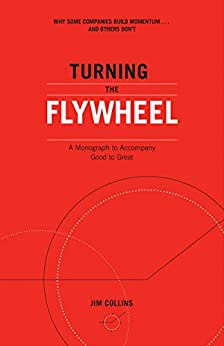More on this book
Community
Kindle Notes & Highlights
by
Jim Collins
Read between
February 28 - March 2, 2019
Notice the inexorable logic. Trace your way around the Amazon flywheel a few times in your mind, and you can almost get swept up in the momentum. Each component in the flywheel sets you up for the next component, indeed, almost throwing you around the loop.
Never underestimate the power of a great flywheel, especially when it builds compounding momentum over a very long time. Once you get your flywheel right, you want to renew and extend that flywheel for years to decades—decision upon decision, action upon action, turn by turn—each loop adding to the cumulative effect. But to best accomplish this, you need to understand how your specific flywheel turns. Your flywheel will almost certainly not be identical to Amazon’s, but it should be just as clear and its logic equally sound.
Notice how each component in the Vanguard flywheel isn’t merely a “next action step on a list” but almost an inevitable consequence of the step that came before.
The Vanguard case exemplifies a key aspect of how the best flywheels work. If you nail one component, you’re propelled into the next component, and the next, and the next, and the next—almost like a chain reaction. In thinking about your own flywheel, it’s absolutely vital that it not be conceived as merely a list of static objectives that you’ve simply drawn as a circle. It must capture the sequence that ignites and accelerates momentum.
the greatest danger in business and life lies not in outright failure but in achieving success without understanding why you were successful in the first place.
One of the biggest, and most common, strategic mistakes lies in failing to aggressively and persistently make the most of victories.
Murat Yilmaz liked this
From its earliest days, Intel built a flywheel harnessing Moore’s Law (the empirical observation that the number of components on an integrated circuit achieved at an affordable cost doubles roughly every eighteen months). From this insight, Intel’s founding team created a strategic compounding machine: Design new chips that customers crave; price high before competition catches up; drive down unit costs as volume increases (due to economies of scale); harvest high profits even as competition drives down prices; and reinvest those profits into R&D to design the next generation of chips. This
...more
For a truly great company, the Big Thing is never any specific line of business or product or idea or invention. The Big Thing is your underlying flywheel architecture, properly conceived.
As Gerard Tellis and Peter Golder demonstrated in their book, Will and Vision, the pioneering innovators in a new business arena almost never (less than 10 percent of the time) become the big winners in the end. Similarly, across all our rigorous matched-pair research studies (Built to Last, Good to Great, How the Mighty Fall, and Great by Choice), we found no systematic correlation between achieving the highest levels of performance and being first into the game.
Murat Yilmaz liked this
Leaders who create pockets of greatness at the unit level of their organization—leaders like school principal Gustafson—don’t sit around hoping for perfection from the organization or system around them. They figure out how to harness the flywheel effect within their unit of responsibility. No matter what your walk of life, no matter how big or small your enterprise, no matter whether it’s for-profit or nonprofit, no matter whether you’re CEO or a unit leader, the question stands, How does your flywheel turn?
Murat Yilmaz liked this
The flywheel, when properly conceived and executed, creates both continuity and change. On the one hand, you need to stay with a flywheel long enough to get its full compounding effect. On the other hand, to keep the flywheel spinning, you need to continually renew, and improve each and every component.
Murat Yilmaz liked this
There are two possible explanations for a stalled or stuck flywheel. Possible explanation #1: The underlying flywheel is just fine, but you’re failing to innovate and execute brilliantly on every single component; the flywheel needs to be reinvigorated. Possible explanation #2: The underlying flywheel no longer fits reality and must be changed in some significant way. It’s imperative that you make the right diagnosis.
Murat Yilmaz liked this
In looking across the history of great companies in all our research studies, we find a frequent pattern. They usually begin life being successful in a specific business arena, making the most of their early big bets. But soon they make a conceptual shift from “running a business” to turning a flywheel. And over time, they extend that flywheel by firing bullets, then cannonballs. They crank the flywheel in their first arena of success, while simultaneously firing bullets to discover new things that might work, and as a hedge against uncertainty.
Murat Yilmaz liked this
Every large organization will eventually have multiple sub-flywheels spinning about, each with its own nuance. But to achieve greatest momentum, they should be held together by an underlying logic. And each sub-flywheel should clearly fit within and contribute to the whole.
In Stage 4, each grasp for salvation creates a burst of hope and momentary momentum. But if there’s no underlying flywheel, the momentum doesn’t last. And with each grasp, the enterprise erodes capital—financial capital, cultural capital, stakeholder capital—and weakens. If the company never gets back to the discipline of the flywheel, it will likely continue to spiral downward until it enters Stage 5. No enterprise comes back from Stage 5. Game over.


